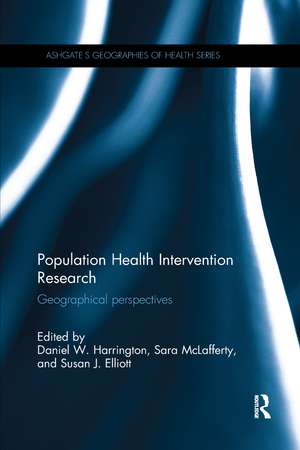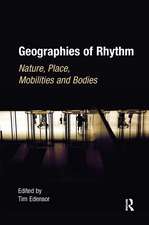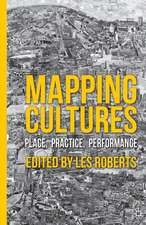Population Health Intervention Research: Geographical perspectives: Geographies of Health Series
Editat de Daniel W. Harrington, Sara McLafferty, Susan J. Elliotten Limba Engleză Paperback – 30 sep 2020
| Toate formatele și edițiile | Preț | Express |
|---|---|---|
| Paperback (1) | 383.83 lei 6-8 săpt. | |
| Taylor & Francis – 30 sep 2020 | 383.83 lei 6-8 săpt. | |
| Hardback (1) | 1055.60 lei 6-8 săpt. | |
| Taylor & Francis – 26 iul 2016 | 1055.60 lei 6-8 săpt. |
Din seria Geographies of Health Series
-
 Preț: 388.30 lei
Preț: 388.30 lei - 23%
 Preț: 322.05 lei
Preț: 322.05 lei - 18%
 Preț: 1118.99 lei
Preț: 1118.99 lei -
 Preț: 489.26 lei
Preț: 489.26 lei -
 Preț: 386.77 lei
Preț: 386.77 lei -
 Preț: 436.14 lei
Preț: 436.14 lei - 16%
 Preț: 260.33 lei
Preț: 260.33 lei -
 Preț: 387.75 lei
Preț: 387.75 lei -
 Preț: 389.38 lei
Preț: 389.38 lei -
 Preț: 436.14 lei
Preț: 436.14 lei -
 Preț: 382.86 lei
Preț: 382.86 lei - 17%
 Preț: 259.98 lei
Preț: 259.98 lei - 17%
 Preț: 259.98 lei
Preț: 259.98 lei -
 Preț: 383.17 lei
Preț: 383.17 lei -
 Preț: 326.49 lei
Preț: 326.49 lei - 18%
 Preț: 1001.21 lei
Preț: 1001.21 lei -
 Preț: 389.66 lei
Preț: 389.66 lei - 18%
 Preț: 1005.73 lei
Preț: 1005.73 lei - 5%
 Preț: 1157.24 lei
Preț: 1157.24 lei
Preț: 383.83 lei
Nou
Puncte Express: 576
Preț estimativ în valută:
73.46€ • 75.88$ • 61.13£
73.46€ • 75.88$ • 61.13£
Carte tipărită la comandă
Livrare economică 26 martie-09 aprilie
Preluare comenzi: 021 569.72.76
Specificații
ISBN-13: 9780367668198
ISBN-10: 036766819X
Pagini: 224
Dimensiuni: 156 x 234 x 12 mm
Greutate: 0.32 kg
Ediția:1
Editura: Taylor & Francis
Colecția Routledge
Seria Geographies of Health Series
Locul publicării:Oxford, United Kingdom
ISBN-10: 036766819X
Pagini: 224
Dimensiuni: 156 x 234 x 12 mm
Greutate: 0.32 kg
Ediția:1
Editura: Taylor & Francis
Colecția Routledge
Seria Geographies of Health Series
Locul publicării:Oxford, United Kingdom
Cuprins
1. Introduction
2. Partnerships to improve population health and health equity: geographic perspectives
3. The vacant land inventory: an approach to support vacant lot redevelopment for population health improvement in Milwaukee, WI, USA
4. Spatial analysis of HIV/AIDS survival in Dallas County, Texas
5. From cultural clashes to settlement stressors: a review of HIV prevention interventions for gay and bisexual immigrant men in North America.
6. Making a place for health in vulnerability analysis: a case study on dengue in Malaysia and Brazil
7. The geography of malaria control in the Democratic Republic of Congo
8. Natural experiments for addressing chronic diseases
9. Shaping the direction of youth health with COMPASS: a research platform for evaluating natural experiments and generating practice-based evidence in school-based prevention
10. School nutrition as an intervention for addressing childhood overweight and obesity
11. Healthy food retail interventions
12. Transforming Local Geographies to Improve Health
2. Partnerships to improve population health and health equity: geographic perspectives
3. The vacant land inventory: an approach to support vacant lot redevelopment for population health improvement in Milwaukee, WI, USA
4. Spatial analysis of HIV/AIDS survival in Dallas County, Texas
5. From cultural clashes to settlement stressors: a review of HIV prevention interventions for gay and bisexual immigrant men in North America.
6. Making a place for health in vulnerability analysis: a case study on dengue in Malaysia and Brazil
7. The geography of malaria control in the Democratic Republic of Congo
8. Natural experiments for addressing chronic diseases
9. Shaping the direction of youth health with COMPASS: a research platform for evaluating natural experiments and generating practice-based evidence in school-based prevention
10. School nutrition as an intervention for addressing childhood overweight and obesity
11. Healthy food retail interventions
12. Transforming Local Geographies to Improve Health
Notă biografică
Daniel W. Harrington is an Epidemiologist Lead at Public Health Ontario, and Adjunct Assistant Professor in the School of Public Health and Health Systems at the University of Waterloo, Canada.
Sara McLafferty is Professor of Geography and Geographic Information Science at the University of Illinois at Urbana-Champaign, USA.
Susan J. Elliott is Professor in the Department of Geography and Environmental Management at the University of Waterloo, Canada.
Sara McLafferty is Professor of Geography and Geographic Information Science at the University of Illinois at Urbana-Champaign, USA.
Susan J. Elliott is Professor in the Department of Geography and Environmental Management at the University of Waterloo, Canada.
Descriere
Representing a diverse array of health concerns ranging across chronic and infectious diseases and including research employing varied qualitative and quantitative methodologies, this book illustrates how geographic concepts and approaches have informed the design and planning of interventions and the evaluation of health impacts. The authors























